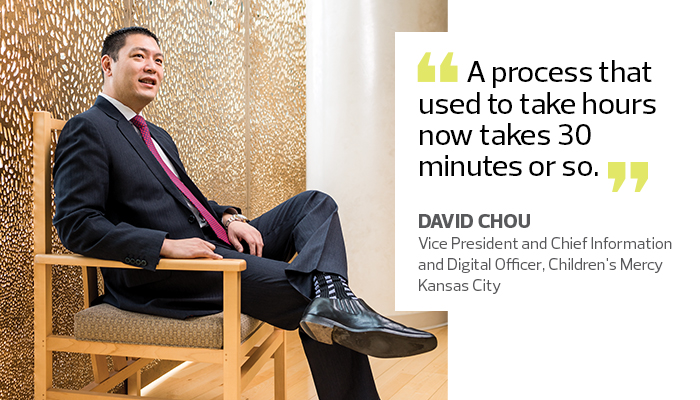Hybrid Cloud Deployments Offer Improved Flexibility to Healthcare Organizations
Jim Livingston is on a mission to bring flexibility to University of Utah Health’s data infrastructure.
The Salt Lake City organization, which comprises four hospitals and 12 community clinics, relies on close to 400 ancillary systems, many of which are legacy software solutions not optimized to be offered as a cloud service. While keeping those tools on-premises remains the best option for now, Livingston, CTO for the University of Utah and University Health, also wants the freedom to move workloads wherever it makes sense. That’s why he’s prioritized a shift into a hybrid cloud setup.
“When we look at new systems, we are adopting a cloud-first, but not a cloud-only, strategy,” he says. “My plan is to give the business the option to do what it needs to do. When I tell other C-level executives that we build out business agility by developing a cloud strategy that uses both the public cloud and our own private cloud, it puts it in terms they understand.”
University of Utah Health deploys data center automation tools and technologies to simplify moving computing jobs between public and private clouds. These include HPE Synergy hardware, hybrid cloud management and data center automation software from Micro Focus, software-defined networking from Cisco ACI and Hitachi Content Platform object storage. The object storage is cloud-enabled and has capabilities to support data lifecycle management based on the policies Livingston’s team sets.
“You could move data from this platform to a low-cost cloud storage service for data archiving and long-term backup, then move it back on-premises if you need to,” he says. “You just set the policy and it automates the process.”
As healthcare organizations look to evolve their workload setups, shifting into a hybrid cloud arrangement enables scalability and modernization, as well as better data accessibility.
Hybrid Cloud Adoption on the Rise in Healthcare
In terms of improved efficiency, Livingston says his team makes provisioning easier for system administrators through data center automation.
“We have brought up a portal that allows users to request the resources they need,” he says. “Users are provided a shopping cart experience, and when they check out, the service is automatically provisioned. If they need a temporary environment that has large RAM requirements, and we don’t have capacity on-premises, we are going to spin that up into the public cloud.”
While the healthcare industry, overall, has been slower to adopt hybrid cloud strategies than other sectors, it’s a scenario that’s quickly changing, says Natasha Gulati, a digital health research manager with Frost & Sullivan.
A hybrid cloud offers two major benefits to healthcare organizations, Gulati says: better optimization of the total cost of ownership and better performance.
“It makes the overall industry cloud architecture more nimble and open so that information flow between workloads within the same provider or between different organizations is easier,” she says. “For example, sensitive patient data, which is traditionally often hosted on private clouds, is easier to submit to insurers for bundled payments via hybrid cloud-based registries that capture data from various other sources.”
Children's Mercy Saves Hours with the Cloud
When David Chou took the position of vice president and chief information and digital officer at Children’s Mercy Hospital in Kansas City, Mo., in 2016, he discovered obvious examples of systems that could be cloud-enabled.
“I was surprised that the hospital was still backing up to tapes and then taking the tapes to offsite storage,” he says.
But upon conducting a cloud-ready assessment of the organization’s software, Chou and his team quickly realized that there were legacy systems that likely never would work in a strictly public cloud setup.
“The third tier contained systems for which it would be impossible unless we changed vendors or the software was completely rewritten in a new language,” Chou says. “Healthcare IT ecosystems tend to have a lot of these legacy systems and tools.”

Photo by Dan Videtich.
That led Children’s Mercy to deploy NetApp tools to back up to Microsoft Azure, a setup that he says saves a tremendous amount of time.
“A process that used to take hours now takes 30 minutes or so,” Chou says. “That also frees up our employees so they can stop monitoring these night jobs and move over to more business-oriented and beneficial things.”
The arrangement also shrinks Children’s Mercy’s physical data center footprint, a trend he anticipates will continue as the organization moves further into the cloud.
UPMC Grabs a Financial Win with Azure
Four years ago, the University of Pittsburgh Medical Center health system somewhat stumbled into its hybrid cloud strategy, says Chris Carmody, UPMC’s senior vice president of enterprise infrastructure.
“The funny thing is, we started with looking at new data center space,” he says.
The 35-hospital nonprofit organization has two data centers, a primary and a backup, that are more than 20 years old. Ultimately, its IT executives decided that solely building a new data center wouldn’t fit with its new vision of growth, which focused more on on-demand scalability.
“We want the flexibility to grow and expand, as well as contract, depending on the business situation,” Carmody says. “We also want to control our data and place it in the public cloud when needed and pull it back in when necessary.”
UPMC built a colocation data center in the Pittsburgh area to its specifications, where it serves as the anchor tenant and shares power, cooling and environmental control costs with the other tenants.

However, the organization also chose to run applications in Azure, Microsoft’s public cloud, at one of its facilities in western Pennsylvania, rather than spend another $1.2 million on new hardware and software in the data center.
“Ultimately, it only cost us tens of thousands of dollars per year to run those applications in Azure versus having to make that huge capital investment,” Carmody says. “That was a big win for us. We focus on using the public cloud for backup, disaster recovery and test environments for systems, and our hybrid cloud approach allowed us to move workloads into the public cloud and back again.”
Hybrid Cloud Offers Healthcare Solid ROI
To date, the hybrid cloud modernization has helped University of Utah Health achieve both a 50 percent reduction in network-attached storage data backup and a 50 percent reduction of backup infrastructure, as well as significant savings overall in place of a traditional infrastructure. That helps the provider organization to efficiently deliver around-the-clock, cost-effective care to all of its patients, Livingston says.
“As we outgrow our data center, I don’t intend to build out additional data center space,” he says. “I can buy space from colocation partners or from the public cloud and seamlessly move workloads without any impact on the organization.”
Like University of Utah Health, UPMC also uses automation tools to fine-tune its utilization of the cloud, Carmody says. The organization has created a variety of tools for both test and development environments that are available during normal business hours, but then are shut down at night.
“The public cloud is basically a running meter, like water or any other utility, where you get charged for how much you use,” he says. “This allows us to control what we pay for in that public cloud environment.”









